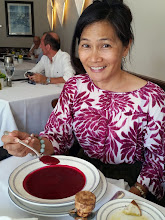The clip he asks to see the most is one of Zimmern eating a beating frog's heart at a street food stall in Tokyo. I asked Seiji about what he likes about watching this. His answer was very matter-of-fact.
"I like gross and it is gross," he said with that eight-year-old candor I have grown to know and love.

Just the facts.
Seiji says that the weirdest thing he has eaten so far is squeaking cheese curds from the Tillamook factory in Oregon. But another kid's "weird" can be another kid's "normal." To the average eight-year-old, squeaking cheese is probably not that unusual compared to other foods that Seiji and his brother Kenzo eat regularly: the odiferous but good-for-you natto or ochazuke a traditional comfort soup - for breakfast.
 Politely borrowed from justhungry.com
Politely borrowed from justhungry.comLike a lot of first-generation kids who are born of parents from other parts of the world, my sisters and I were fed for the most part, what they thought American kids would eat. This meant McDonald's, spaghetti, and thick steaks. Filipino food was optional, experienced mainly on holidays at relatives' homes and dismissed by our parents, who would say self-deprecatingly, "You wouldn't like it."
Being kids we favored sweet and starchy dishes. The Filipino dishes that we did enjoy reflected this: the comfort of lugao or arroz caldo or the afterschool treat of Mom's banana fritters. In retrospect, dishes like dinuguan, which my mom optimistically called, "chocolate meat," was really not that bad despite its main ingredient. And thanks to our dad, we never feared tripe, dried anchovies, or shellfish. We got to taste chayote squash, figs, char siu bao, and tofu long before they became as common in American cuisine as they are today.
Everything my parents served however, was not a hit, and it wasn't always because of a food's exotic origin. I hated Ovaltine, both the malt and the chocolate. We were probably the last generation that had to eat liver. But the unexpected gift here, despite our turned-up noses, is that by the sheer luck of where our parents happened to be born, we had the chance to try things and develop a more global sensibility about food.

Bittermelon - even in snack chip form - is still no deal.
If you were to judge my sisters and I by our school lunchboxes, we were typical American kids. We ate bologna or peanut butter and jelly sandwiches, little bags of Laura Scudder's cheese curls and potato chips - which were ironically decorated with flags and children of the world - and the entire line of Dolly Madison baked goods. Our parochial school did not have a cafeteria, but every Thursday a few of the mothers cooked a hot lunch for us in the church's social hall. There I could sample "real" American kid food. Miniature frozen cheese pizzas with their slabs of melted cheese and slightly sweet sauce are still the gold standard of what I like in a pizza. Chili dogs and "home" tacos were my introduction to spicy food and sloppy joes gave me my love of saucy, messy fare.

So politically incorrect. And so good, at least in the third grade. Lifted with envy from fabulous retro Flickr site.
Kids, whose palates are as yet unjaded by a lifetime of eating, have very sensitive tastebuds. When they find something they really like, they seriously consider eating it all the time.
"Udon is my favorite food," says Seiji. "I wish I could eat it all the time."
When I was a kid, I wished I could eat spaghetti all of the time. And when I learned how to cook, I did just that. Curiosity - and finally, a driver's license - led me to explore other kinds of food, guided by what my friends' parents would serve, my obsession with cookbooks and food magazines, and that all-encompassing desire to seem "grown-up." I would drive from my quiet suburb all over Los Angeles in search of the ultimate knish, Southern barbeque, or ramen.

You can go home again... and again... and again. Still crazy about Canter's after all these years.
Seiji and his brother Kenzo are lucky to grow up in a family that celebrates its collective culinary heritage. We are also obsessed with the art of food from around the world and are blessed with a variety of friends who share their traditions and cuisines. I hope when the boys are older they will be curious enough to explore the world through their palates. When I was younger, I thought I could see the world from the dining table - and often, I still do.






Thanks to Larry for the Remy and Andrew Zimmern clips, Jolene for her curiosity in a Chinatown shop of dried fruits and nuts, Hiro for the ochazuke, and most of all, Seiji, for being the inspiration for this post!
ReplyDelete